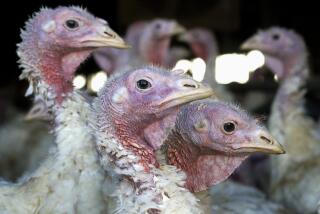Good nesting season may mean more grouse this fall
- Share via
Grouse hunters in both Minnesota and Wisconsin should see seasons similar to last year’s, if not a bit better, according to grouse experts in both states.
The ruffed grouse season opens Saturday and continues through Jan. 31 in Wisconsin’s northern zone. Minnesota’s statewide ruffed grouse season opens Sept. 19 and continues through Jan. 3.
Annual spring grouse drumming surveys in both states put the grouse index at about the same levels as in 2014. But good weather during the nesting and brood-rearing season should bode well for the birds, biologists and others said.
“We had a good bump (in drumming counts) last year, and the counts were stable this year,” said Nick Larson of Duluth, Minnesota regional director for the Ruffed Grouse Society. “I think it’s going to be a better season than the drumming counts indicate.”
Ted Dick, upland game bird coordinator for the Minnesota Department of Natural Resources, agrees.
“I’m going out on a limb and saying recruitment (of young grouse) was pretty good,” Dick said. “You want weather in June that’s warm and on the dry side, and it was pretty warm and dry in June. That can make a difference in the fall even if the drumming counts held steady from last year.”
Greg Kessler, Wisconsin DNR wildlife biologist at Brule, is equally optimistic.
“The late June and July brood conditions were really good,” Kessler said. “I’ve heard lots of reports from foresters who are seeing young grouse. And on my own, not during work hours, I’ve seen a fair number of broods myself. My anticipation is a better fall than we’ve seen in the last four or five years, although nowhere near the peak of the cycle.”
Minnesota’s ruffed grouse drumming counts this past spring were statistically unchanged from 2014, according to the DNR, after being up 34 percent in 2014 compared to 2013. This year’s counts turned up 1.3 drums per stop in the northeast survey region, which is the heart of grouse range in Minnesota. That was the same as in 2014. Observers recorded 1.1 drums per stop statewide. Minnesota’s grouse counts vary between lows of about 0.6 drums per stop during bad years to about 2.0 during peak population years.
Population cycle
The ruffed grouse population in northern states tends to rise and fall on about a 10-year cycle. Minnesota’s ruffed grouse numbers peaked most recently in the fall of 2010, and Wisconsin’s in 2011. Populations tend to peak near the beginning or end of each decade, with lows occurring mid-decade.
Population cycles are only part of what determines how many birds hunters will find in the woods each fall. Spring nesting success also plays an important role in determining bird numbers.
“I’ve always thought a good spring and a good hatch will give hunters a better season than the drumming counts indicate,” said the Ruffed Grouse Society’s Larson. “You have so many young birds out there, and they seem to be the ones people contact. They’re easier to hunt.
“I’m not a biologist, but overall, it’s felt like a beautiful summer. In June, we didn’t have those drizzly, foggy days we’re so accustomed to.”
Wisconsin’s counts
Wisconsin’s statewide grouse counts this past spring were essentially unchanged from 2014, DNR officials said, but there was some variability by region. The northern region showed a 13 percent drop in the number of drums heard per stop, while the primary region in central Wisconsin showed a 38 percent increase.
The DNR’s Kessler remains upbeat about grouse hunting in the northern region.
“In talking to hunters and foresters, we had pockets of really good hunting last year,” Kessler said, “and they should spread to more and wider areas. I think we’ll have areas where guys are happy with what they find.”
(c)2015 Duluth News Tribune (Duluth, Minn.)
Visit the Duluth News Tribune (Duluth, Minn.) at www.duluthnewstribune.com
Distributed by Tribune Content Agency, LLC.
More to Read
Go beyond the scoreboard
Get the latest on L.A.'s teams in the daily Sports Report newsletter.
You may occasionally receive promotional content from the Los Angeles Times.









